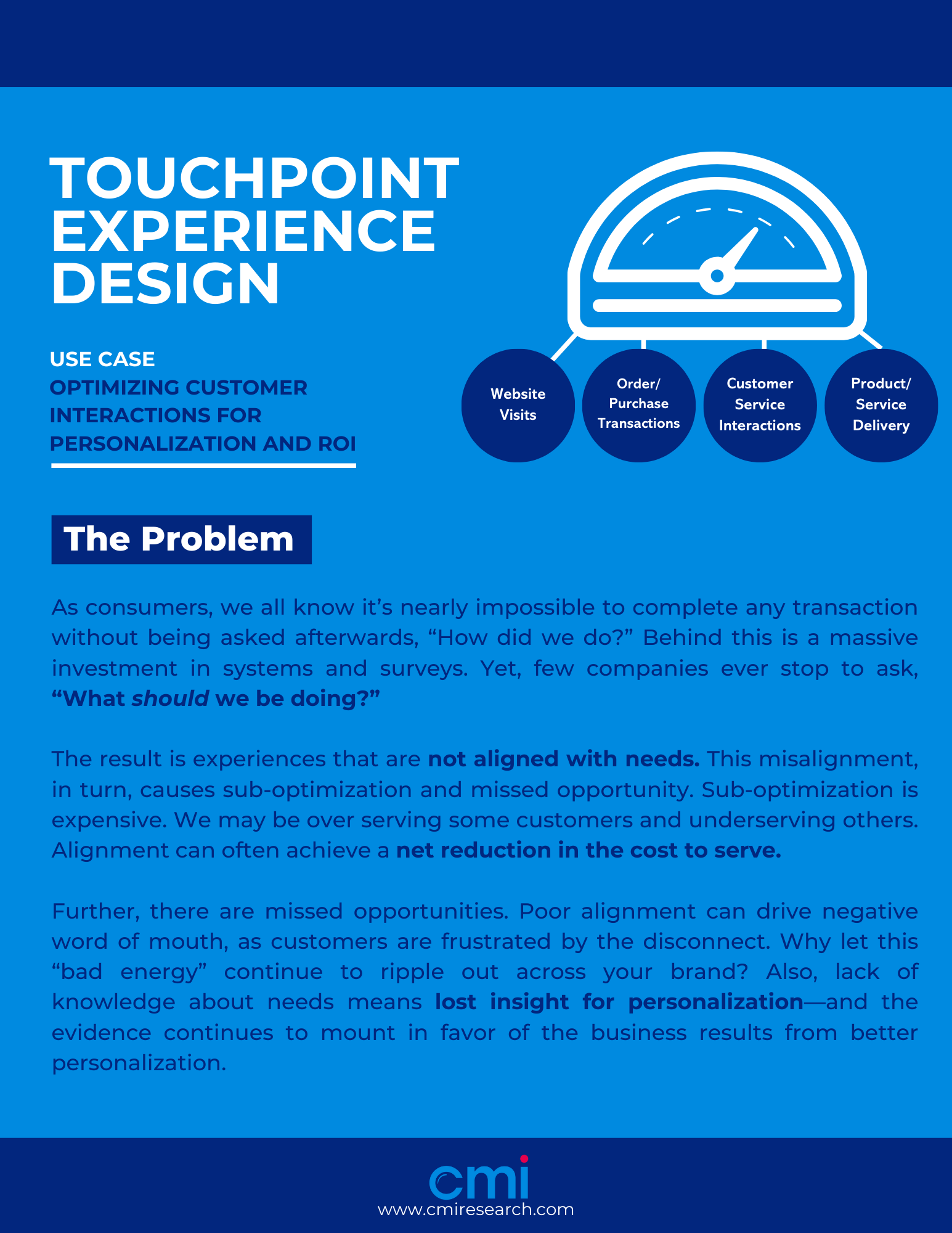

-
Infographic Transcript
TOUCHPOINT EXPERIENCE DESIGN
USE CASE: OPTIMIZING CUSTOMER INTERACTIONS FOR PERSONALIZATION AND ROI
- Website Visits
- Order/ Purchase Transactions
- Customer Service Interactions
- Product/ Service Delivery
The Problem
As consumers, we all know it’s nearly impossible to complete any transaction without being asked afterwards, “How did we do?” Behind this is a massive investment in systems and surveys. Yet, few companies ever stop to ask,
“What should we be doing?”
The result is experiences that are not aligned with needs. This misalignment, in turn, causes sub-optimization and missed opportunity. Sub-optimization is expensive. We may be over serving some customers and underserving others.
Alignment can often achieve a net reduction in the cost to serve.
Further, there are missed opportunities. Poor alignment can drive negative word of mouth, as customers are frustrated by the disconnect. Why let this
“bad energy” continue to ripple out across your brand? Also, lack of knowledge about needs means lost insight for personalization-and the evidence continues to mount in favor of the business results from better personalization.
The Solution
Touchpoint Experience Design (T.E.D.) is a research and consulting methodology that guides you to optimize the design of your touchpoint experiences. In contrast to broad, descriptive methods such as customer journey mapping, T.E.D. uncovers what customers need at the granular level you need for CX design. And, importantly, T.E.D. allows you to look at needs through multiple lenses (e.g., journeys, customer segments). The result is the tactical insight you need to make evidence-based decisions that can reduce costs and dial-up personalization where it can truly influence customer loyalty.
How Does It Work?
As a customized solution, T.E.D. is tailored to your objectives and business environment. The following steps describe the general flow of a typical project.
Step 1: Blueprinting
Blueprinting is the groundwork. It sets the scope (all touchpoints, or more narrowly focused?) and organizes what you already know about touchpoint-level customer needs. Input may include interviews with customer facing staff and/or external qualitative research with customers.
Step 2: Measurement
What are customers’ performance standards? Do they have specific channel preferences for certain kinds of interactions? Will they pay for enhanced service levels?
Are there journey or segment differences? These are the kinds of questions that the measurement phase can address. It also includes the choice modeling analytics that deliver the details for experience design.
Step 3: Workshop
The best insights in the world have no value if your stakeholders aren’t empowered to use them. We need to work through the results in dialogue with your leaders to make sure the bridges between insights and action are solid. If there are obstacles, we need to identify them and determine the path forward to activation.
The Results
In one case T.E.D. enabled a Fortune 500 B2B technology and services provider to move over 200,000 customers from high-cost field sales rep support to much lower-cost call center reps, with a positive impact on customer loyalty. How was this possible? Because the call center was a better fit for this customer segment’s needs.
This is the “holy grail” in CX: decreasing costs and increasing customer lifetime value (through higher loyalty) at the same time.
For further information contact Brian S. Lunde
